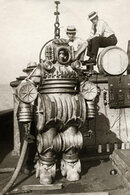Where did you saw that? I believe I made my position super clear. As I said, more and more YOKE users are changing to DIN in areas where YOKE is predominant. In this case it is US, it could be Wakanda (forever) instead, for me it is exactly the same. Perhaps we could have a little poll now and another one in a couple years to follow up the development?
DIN valves were actually invented by the US in the 50s for commercial diving. The Germans only improved upon the design. So you can all be proud.
DIN withstand higher pressures than YOKE, the O-rings are less exposed to the elements and usually in much better condition. Both O-rings are put under pressure but one O-ring is thicker and cannot move once pressurized while the other is thinner and sandwiched between 2 layers of metal that can be bumped and moved in any position. Also, the YOKE protrudes more than a DIN setup and therefore minimized the risk of entanglement or hitting it in any overhead environment. Those are the reasons why Tech divers, Cave divers and Wreck divers prefer DIN.
In the American NOAA (Office of Marine and Aviation Operations) manual it is stated that '
the DIN connection for regulators and valves is a more reliable connection than the more common YOKE fitting and is designed to work at higher pressures. With a DIN regulator and valve systems, the 1st stage actually threads into the valve body. The principle behind the DIN fittings is known as a "captured O-ring" because once the regulator is screwed into the valve, it is almost impossible for a O-ring failure to cause a loss of breathing gas...'
More reliable = Safer in my book (it seems in yours also as you chose DIN as well).
I agree with the argument that Compressors use A-Clamps for faster filling as well as the stress being reduced while filling vs a DIN fitting. Also if you are a kid, a woman or someone with smaller hands, removing an overtightened DIN stage can be challenging.
I also agree that it will take time to change, it always does and there will always be people that refuse to change.
In EU, we use a Donut insert when transporting our tanks. In the majority of Dive Centers this is only removed when attaching our regs and prevents any bending. If the hit is extremely hard, the only thing that can happen is that the insert becomes permanently 'fused' to the valve, becoming a YOKE. Folks learned from their mistakes.
Your DIN 200/300 BAR assessment is also correct. The 200 variants basically don't 'exist' anymore. Mind that in the majority of the Dive Centers we fill our 12L steel bottles anywhere from 220-230 bars (below the real limit and depending on the state and age of the tanks). That's an average of 3191 PSI on the lower end. I believe your AL tanks are rated below that?
Never agree with anyone saying that YOKE is garbage. It is sufficient for many folks although IMO the DIN advantages are far more important (safety, weight, size) than 15sec I need to remove the Donut or have to screw in an adapter if the Dive Center has outdated or insufficient gear.
Dive safe.





